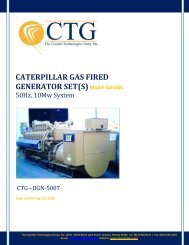The Role of Distributed Generation in Power Quality and Reliability
The Role of Distributed Generation in Power Quality and Reliability
The Role of Distributed Generation in Power Quality and Reliability
Create successful ePaper yourself
Turn your PDF publications into a flip-book with our unique Google optimized e-Paper software.
m<strong>in</strong>imum acceptable (M<strong>in</strong>imum) <strong>and</strong> desirable (Objective) levels <strong>of</strong> reliability. <strong>Reliability</strong> is<br />
gauged utiliz<strong>in</strong>g <strong>in</strong>dices for both the frequency <strong>and</strong> duration <strong>of</strong> service <strong>in</strong>terruptions. <strong>The</strong><br />
recommended reliability levels are customized for each <strong>of</strong> the utility operat<strong>in</strong>g areas <strong>in</strong> the State.<br />
<strong>The</strong> Order also <strong>in</strong>cludes criteria for identify<strong>in</strong>g, rank<strong>in</strong>g, <strong>and</strong> develop<strong>in</strong>g appropriate<br />
improvement plans for the worst-perform<strong>in</strong>g circuits <strong>in</strong> each operat<strong>in</strong>g area. In addition, the<br />
utilities are required to develop programs for respond<strong>in</strong>g to customers' power quality problems.<br />
<strong>The</strong>se reports have created a common set <strong>of</strong> metrics for def<strong>in</strong><strong>in</strong>g the issue <strong>in</strong> terms <strong>of</strong> average<br />
<strong>in</strong>terruption frequency, average <strong>in</strong>terruption duration, <strong>and</strong> average service restoration time.<br />
Review <strong>of</strong> the PQRs from the major <strong>in</strong>vestor-owned utilities <strong>in</strong> the state shows that high/low<br />
voltage excursions ranged from 160 to 281 <strong>in</strong>cidents per year by region for one utility. Voltage<br />
quality issues occurred thous<strong>and</strong>s <strong>of</strong> times per year with<strong>in</strong> each service region. Utilities have<br />
also engaged <strong>in</strong> case studies <strong>and</strong> customer <strong>in</strong>terviews <strong>in</strong> an attempt to better quantify the issues<br />
<strong>and</strong> improve operations.<br />
New York Customer Views <strong>of</strong> <strong>Power</strong> <strong>Quality</strong> <strong>and</strong> Utility Response<br />
<strong>The</strong> project team spoke with n<strong>in</strong>e facility managers <strong>in</strong> sensitive <strong>in</strong>dustries throughout New York<br />
State about their power quality <strong>and</strong> reliability issues. While, the very dramatic extended<br />
Northeast blackout <strong>of</strong> 2003 created problems for most <strong>of</strong> them, this once <strong>in</strong> 25 year event is not<br />
as important as the more subtle <strong>and</strong> more frequent disturbances these facilities experience every<br />
year, every summer, <strong>and</strong>, <strong>in</strong> some cases, nearly every day. Problems arise with computers,<br />
microprocessors, fluorescent light ballasts, sensitive medical imag<strong>in</strong>g equipment, variable speed<br />
drives, computer directed design <strong>and</strong> manufactur<strong>in</strong>g, critical communications equipment,<br />
nuisance trips on circuit breakers, overheat<strong>in</strong>g <strong>of</strong> equipment, etc. Some facilities don’t know<br />
what is caus<strong>in</strong>g their equipment to break, go <strong>of</strong>f-l<strong>in</strong>e or lose data, they just go <strong>in</strong> <strong>and</strong> fix it to their<br />
systems get back up <strong>and</strong> runn<strong>in</strong>g. Other facilities have become very sophisticated <strong>in</strong> monitor<strong>in</strong>g<br />
their power signal <strong>and</strong> <strong>in</strong> diagnos<strong>in</strong>g problems.<br />
Still, from the perspective <strong>of</strong> the customers contacted for this study, utilities were generally not<br />
helpful <strong>in</strong> identify<strong>in</strong>g <strong>and</strong> diagnos<strong>in</strong>g power quality problems. Consequently, to get to the root<br />
<strong>of</strong> PQ related problems, customers had to <strong>in</strong>stall monitor<strong>in</strong>g equipment <strong>and</strong> identify <strong>and</strong> diagnose<br />
the problems themselves. Armed with such <strong>in</strong>vestigative data, some customers were then able to<br />
get the utility to act to correct persistent low voltage or phase imbalance conditions.<br />
All <strong>of</strong> them have made some level <strong>of</strong> power quality/reliability enhanc<strong>in</strong>g <strong>in</strong>vestments to protect<br />
their operations. Both centralized <strong>and</strong> equipment level UPS systems were used. <strong>Power</strong> factor<br />
correction, harmonic filters, isolation transformers, <strong>and</strong> other equipment were also used to<br />
support specific facility issues. Most <strong>in</strong>cluded st<strong>and</strong>by generation as part <strong>of</strong> their protection<br />
scheme. Two facilities had <strong>in</strong>-place <strong>and</strong> operat<strong>in</strong>g comb<strong>in</strong>ed heat <strong>and</strong> power facilities <strong>and</strong> a<br />
number <strong>of</strong> others had done CHP feasibility studies. Of the two operat<strong>in</strong>g CHP systems, one was<br />
an <strong>in</strong>tegral part <strong>of</strong> the facility power-quality protection system. In the other case, the facility<br />
manager was very <strong>in</strong>terested <strong>in</strong> this issue but had been unable to <strong>in</strong>stall a system capable <strong>of</strong><br />
runn<strong>in</strong>g <strong>in</strong>dependently <strong>of</strong> the grid due to restrictive utility <strong>in</strong>terconnect requirements. He was<br />
cont<strong>in</strong>u<strong>in</strong>g to push the utility for addition <strong>of</strong> that capability to his DG system. One facility, <strong>in</strong><br />
Executive Summary ES8 <strong>The</strong> <strong>Role</strong> <strong>of</strong> DG <strong>in</strong> <strong>Power</strong> <strong>Reliability</strong>

















